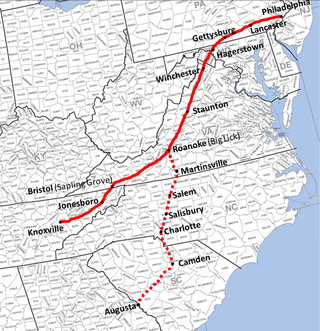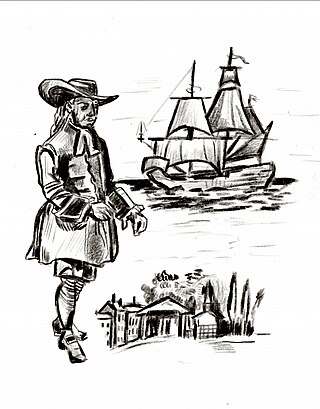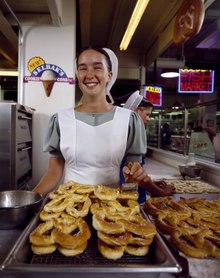
The Pennsylvania Dutch, commonly referred to as Pennsylvania Germans, are an ethnic group in Pennsylvania and other regions of the United States, predominantly in the Mid-Atlantic region of the nation. They largely descend from the Palatinate region of Germany, and settled in Pennsylvania during the 17th, 18th, and 19th centuries. While most were from the Palatinate region of Germany, a lesser number were from other German-speaking areas of Germany and Europe, including Baden-Württemberg, Hesse, Saxony, and Rhineland in Germany, the Netherlands, Switzerland, and the Alsace-Lorraine region of France.

Benjamin Chew was a fifth-generation American, a Quaker-born legal scholar, prominent and successful Philadelphia lawyer, slaveowner, and chief justice of the Supreme Court of the Province of Pennsylvania and later the Commonwealth of Pennsylvania. Chew was known for precision and brevity in his legal arguments and his excellent memory, judgment, and knowledge of statutory law. His primary allegiance was to the supremacy of law and the constitution.

Germantown is an area in Northwest Philadelphia, Pennsylvania. Founded by Palatine, Quaker, and Mennonite families in 1683 as an independent borough, it was absorbed into Philadelphia in 1854. The area, which is about six miles northwest from the city center, now consists of two neighborhoods: 'Germantown' and 'East Germantown'.

Plain people are Christian groups in the United States, characterized by separation from the world and by simple living, including plain dressing in modest clothing. Many plain people have an Anabaptist background. These denominations are largely of German, Swiss German and Dutch ancestry, though people of diverse backgrounds have been incorporated into them. Conservative Friends are traditional Quakers who are also considered plain people; they come from a variety of different ethnic backgrounds.

The Schwarzenau Brethren, the German Baptist Brethren, Dunkers, Dunkards, Tunkers, or sometimes simply called the German Baptists, are an Anabaptist group that dissented from Roman Catholic, Lutheran and Reformed European state churches during the 17th and 18th centuries. German Baptist Brethren emerged in some German-speaking states in western and southwestern parts of the Holy Roman Empire as a result of the Radical Pietist revival movement of the late 17th and early 18th centuries.

The Dunkard Brethren Church is a Conservative Anabaptist denomination of the Schwarzenau Brethren tradition, which organized in 1926 when they withdrew from the Church of the Brethren in the United States.

The Pennsylvania Dutch Country, or Pennsylvania Dutchland, is a region of German Pennsylvania spanning the Delaware Valley and South Central and Northeastern regions of Pennsylvania.

The Fancy Dutch, also known as the High Dutch, and historically as the Pennsylvania High Germans, are the Pennsylvania Dutch who do not belong to Plain Dutch sects. Unlike the Amish, the conservative Dunkards, or Old Order Mennonites, they do not wear plain clothing, and they fight in wars. Many popularly associated characteristics of Pennsylvania Dutch culture, including spielwerk, hex signs, and other aspects of Pennsylvania Dutch art, music, and folklore, are derived from the Fancy Dutch. The tourism industry and mainstream media often erroneously attribute such contributions to the more conservative Plain Dutch, though they would reject these aspects of their more worldly Fancy counterparts.

Francis Daniel Pastorius was a German-born educator, lawyer, poet, and public official. He was the founder of Germantown, Pennsylvania, now part of Philadelphia, the first permanent German-American settlement and the gateway for subsequent emigrants from Germany.

The Religious Society of Friends, better known as the Quakers, played a major role in the abolition movement against slavery in both the United Kingdom and in the United States. Quakers were among the first white people to denounce slavery in the American colonies and Europe, and the Society of Friends became the first organization to take a collective stand against both slavery and the slave trade, later spearheading the international and ecumenical campaigns against slavery.

Beggarstown or Bettelhausen was a small community that was located in the present day neighborhood of Mount Airy in Northwest Philadelphia in the U.S. state of Pennsylvania. It centered primarily along a stretch of relatively flat land along Germantown Avenue roughly between Upsal Street and Gorgas Lane.

Alexander Mack was a German clergyman and the leader and first minister of the Schwarzenau Brethren in the Schwarzenau, Wittgenstein, community of modern-day Bad Berleburg, North Rhine-Westphalia, Germany. Mack founded the Brethren along with seven other Radical Pietists in Schwarzenau in 1708. Mack and the rest of the early Brethren emigrated to the United States in the mid-18th century, where he continued to minister to the Brethren community until his death.

The 1688 Germantown Quaker Petition Against Slavery was the first protest against enslavement of Africans made by a religious body in the Thirteen Colonies. Francis Daniel Pastorius authored the petition; he and the three other Quakers living in Germantown, Pennsylvania, Garret Hendericks, Derick op den Graeff, and Abraham op den Graeff, signed it on behalf of the Germantown Meeting of the Religious Society of Friends. Clearly a highly controversial document, Friends forwarded it up the hierarchical chain of their administrative structure—monthly, quarterly, and yearly meetings—without either approving or rejecting it. The petition effectively disappeared for 150 years into Philadelphia Yearly Meeting's capacious archives; but upon rediscovery in 1844 by Philadelphia antiquarian Nathan Kite, latter-day abolitionists published it in 1844 in The Friend, in support of their antislavery agitation.

Abraham Isaacs op den Graeff, also Op den Graff, Opdengraef as well as Op den Gräff was one of the so-called Original 13, the first closed group of German emigrants to North America, and an original founder of Germantown, Pennsylvania, as well as a civic leader, member of the Pennsylvania Provincial Assembly, award-winning weaver, and as an early abolitionist signer of the first organized religious protest against slavery in colonial America. He, or his brother Derick op den Graeff, are briefly mentioned in John Greenleaf Whittier's poem "The Pennsylvania Pilgrim" simply as "Op Den Graaf".
Op den Graeff is a German and American family of Dutch origin. They were one of the first families of the Mennonite faith in Krefeld at the beginning of the 17th century. Various family members belonged to Original 13, the first organized immigration of a closed group of Germans to America in 1683. There the family had a long history in religious service and politics, beginning in the late 17th century in the Colony of Pennsylvania. In 1688, they became forerunners of the anti-slavery movement by signing the first anti-slavery protest in North America. Their descendants spread into various lines, Updegraff, Uptegraft, Updegraft, Updegrave, Updegrove, Uptegrove, Ubdegrove, Uptegraph, Upthagrove. The Updegraff branch of Ohio belonged to the leading families of the Quaker religious movement and produced a long line of ministers and elders.

Old Order Anabaptism encompasses those groups which have preserved the old ways of Anabaptist Christian religion and lifestyle.

The Shenandoah Valley region of Virginia and parts of West Virginia is home to a long-established German-American community dating to the 17th century. The earliest German settlers to Shenandoah, sometimes known as the Shenandoah Deitsch or the Valley Dutch, were Pennsylvania Dutch migrants who traveled from southeastern Pennsylvania. These German settlers traveled southward along what became known as the Great Wagon Road. They were descendants of German, Swiss, and Alsatian Protestants who began settling in Pennsylvania during the late 1600s. Among them were German Palatines who had fled the Rhineland-Palatinate region of southwestern Germany due to religious and political persecution during repeated invasions by French troops.
Thones Dennis Kunders was an early settler of colonial Pennsylvania.

Derick Isaacs op den Graeff, also Dirk, Dirck, Derrick Isaacs op den Graeff, Opdengraef, Opdengraff as well as Op den Gräff was one of the so-called Original 13, the first closed group of German emigrants to North America, an original founder of Germantown, Pennsylvania, as well as a civic leader. As an early abolitionist He was a signer of the first organized religious protest against slavery in colonial America. He, or his brother Abraham op den Graeff, are briefly mentioned in John Greenleaf Whittier's poem "The Pennsylvania Pilgrim" simply as "Op Den Graaf".

Herman Isacks op den Graeff, also Herman op den Graeff, Opdengraef, Opdengraff as well as Op den Gräff was one of the so-called Original 13, the first closed group of German emigrants to North America and an original founder of Germantown, Pennsylvania. He was an outspoken anti slavery man and abolitionist.





















